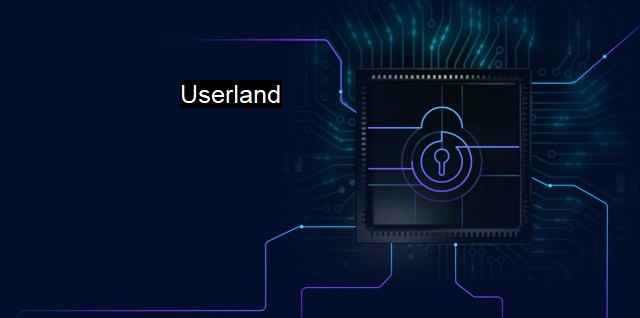What is Userland?
Understanding Userland: Securing Your OS against Malware and Cyber Threats
"Userland" , a term widely used in the field of cybersecurity and also in the arena of antivirus technology, refers to an area of a computer system where application software and certain aspects of the operating system, executables which run in user mode, operate. Considering the overall mechanism of a computer operating system, it could be fundamentally bifurcated into two distinct spaces - kernelspace and userspace. The former, kernelspace, is a highly privileged area of the memory where the kernel, the central module of an operative system, runs. In contrast to this, userland or userspace is that area where non-privileged services or applications made by users, are executed.Looking closely at its structure, userspace in any operating system kernel application, provides user applications with access to system services. The evident division of work in a computer system between these two separate spaces exist for the overarching purpose of limiting possible avenues for malicious or erroneous software from obstructing the kernel’s processing. Thus, the basic intent in the stratification of a system between kernelspace and userspace is to reinforce the system robustness and prevent it from being compromised.
From a cybersecurity perspective, ‘userland’ emulates a significance. Malware and viruses often prioritize their launches from userspace rather than operating within kernelspace. The fundamental reason behind this is that most applications adventurous enough to try infiltrating the kernelspace are usually trapped and eliminated by the protective rings around the kernel. Therefore, majority of malware targeting these applications often run in userland where lower levels of sanction permission are required for functioning. Though this potentially makes userland relatively more susceptible to external infiltrations, it also segregates critical system functions into a restricted area and hence minimize potential damage to the system itself.
"Userland" is also the area where antivirus programmes are extensively implemented. Antivirus software, significantly constructed to scan, drape and remove cyber threats from computers, most often operate from within the userland. They diligently surveil the activities within userland to identify any malicious programmes trying to interfere with its safe operation. The software initiates cleaning and remediation programmes once threat is identified, working to enter into a disinfection routine. Most antivirus software hence, operate within the same realm as their adversaries, in userland, effectively keeping malicious objects isolated away from more privileged system areas.
While the idea behind userland protections revolves around stonewalling the kernel for unapproved access, it has worthy implications for securing system’s cybersecurity posture. Since much of the malware tries to compromise systems through the userland, security professionals are persistently employing userland protections that allow them to keep pace with the ever-evolving nature of threats. Antivirus software continuously update their definitions to stay aware of the changing approaches of malware attacks. This ability to adapt to the changing landscape of userspace operations is a prominent tool in maintaining secure and efficient computer systems .
It should be noted that, while the cybersecurity benefits of userland are significant, this system is not entirely foolproof in ensuring protection against all forms of cyber threats. Cybersecurity threats are continually evolving and hackers are becoming increasingly adept at manipulating exploits and loopholes existing within userspace applications. Therefore, the concept of Userland is of cardinal interest as it epitomizes frontline in the battle against cyber threats.
"Userland" is a crucial aspect of antivirus technology and cybersecurity. It can be imagined as a perilous territory, where software, both legitimate and malicious, carry out their operations in a user-executable part of the operating system. The role it plays being the arena for antivirus operations and the commonly targeted realm of cyber threats, makes understanding userspace extremely necessary in navigating these complex environments. But while this division of userland and kernelspace provides a strong defense against malicious attacks, evolving threats mandate a constant need for development and reinforcement of userland's protective organ.

Userland FAQs
What is userland?
Userland refers to the higher-level layer of an operating system where user applications run. It is the part of the operating system where users interact with the system and execute applications.What is the importance of userland in cybersecurity?
Userland is an important layer in cybersecurity because it is where most of the attacks from malware, viruses and other malicious software happen. Securing the userland is essential to prevent these attacks and keep the system and its data safe.What is antivirus software and how does it work in userland?
Antivirus software is a cybersecurity tool that protects against malicious code by detecting and removing it from the system. Antivirus software works in userland by performing scans of the system, monitoring the behavior of the applications and processes running in userland, and alerting the user if it detects any malicious activity.How can I improve userland security?
You can improve userland security by following some best practices such as keeping the operating system and applications updated, using strong passwords and two-factor authentication, avoiding suspicious emails and websites, using reputable anti-virus software, and regularly backing up important data. It is also important to be vigilant and report any suspicious activity or signs of a security breach.| | A | | | B | | | C | | | D | | | E | | | F | | | G | | | H | | | I | | | J | | | K | | | L | | | M | |
| | N | | | O | | | P | | | Q | | | R | | | S | | | T | | | U | | | V | | | W | | | X | | | Y | | | Z | |
| | 1 | | | 2 | | | 3 | | | 4 | | | 7 | | | 8 | | |||||||